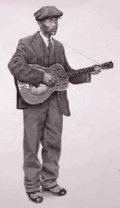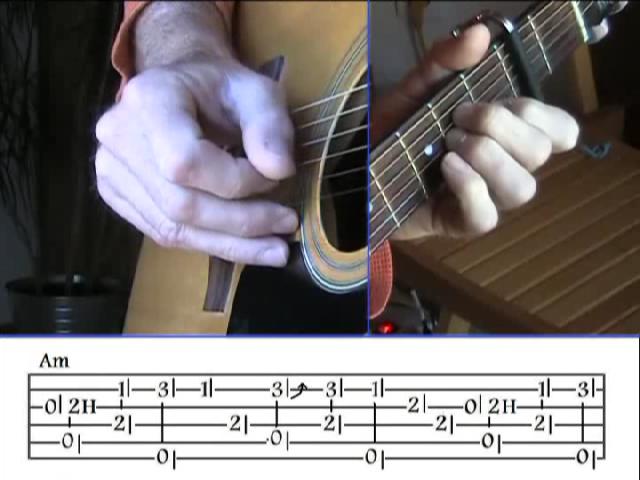Acoustic Blues Guitar Video Lesson Preview - Diddy Wah Diddy Blind Blake.
 Blind Blake as an amazing guitar picker and copying his work is one of the greatest challenges for a modern finger picking guitarist.
Blind Blake as an amazing guitar picker and copying his work is one of the greatest challenges for a modern finger picking guitarist.
I often adapt the work of some of the great blues men, but some of them are so unique (Blake, Broonzy, Reverend Gary Davis) that I try to tab their songs exactly as they were. Generally it's not too difficult to work out where Blake's finger went, but it's the sheer speed and efficiency of his technique that defeats us.
There a several tuition packages out there for Diddy Wah Diddy, such as Stephan Grossman's, but he doesn't play it like Blake. This is a big danger when studying this old music - when we come across something that's too tough for us to play we tend to simplify it and play it that way. This is a big shame. It dilutes the power of the music and doesn't pay homage to the genius of these old blues men. The form of DWD is well known and was played by several ragtime blues guitarists. Blind Boy Fuller played a version called Truckin' Little Baby, played in a slower South Carolina Piedmont style.
The form of DWD is well known and was played by several ragtime blues guitarists. Blind Boy Fuller played a version called Truckin' Little Baby, played in a slower South Carolina Piedmont style.
It's the enormous variety in picking patterns and the speed of Blake's delivery that makes this song very special. It contains all of Blake's tricks - thumb rolls on the basses, triplets on the trebles and lightnin' fast single string runs played with a combination of alternating finger and thumb.
The single string run is one of the things that gives us a problem when learning Diddie. It's not immediately clear which fingers he uses, so we have to make choices based on what we hear and also for our own comfort zone.
In some places, for example, I suspect he uses an arpeggio picking style, with two or three finger rapidly following the next. When we do choose a particular way of picking the strings, the key Question is - Does it sound like the original?
 How To Get that Blake Guitar Sound
How To Get that Blake Guitar Sound
If it doesn't, and it mostly a timing issue, then it's either time to re-think it or just go with something as close as we can get. Writing down the tab for fast ragtime is challenging also, but I thoroughly recommend it as an exercise.
Once you've done this, and get it something like 'right', you really know the music. Tool often in the past, particularly when quite young and before discovering guitar tablature (Thanks Mr Grossman) I would, as a friend once suggested, 'throw my fingers at the strings and hope that some of them stick on the right strings'!
The only chance you have of playing this stuff is to painstakingly go through it slowly and build up the speed a little every day. During my own practice session, for instance, I have a basic repertoire that I like and play in public, so I rapidly play just one verse and a break of each to keep my hand in.
If I'm learning a new piece of music, I play that piece 5 times at the beginning of the practice session and 5 times at the end. I try and practice 30 mins in the morning and also in the evening. Strangely enough, I find that the morning session is much better and productive.
Diddie Wah Diddie is played in the key of C
and the chord progression goes like this - C,C7,F,C,G with a fast turnaround between the verses. The song is filled with challenges, and the first one is thumb control.Not only do we need a solid alternating bass pattern, but Blake also rolls his thumb across two bass strings from time to time, creating two strikes per beat instead of one.
On top of that he might reverse the order of the strings he's alternating between and sometimes break out of the pattern to stop-time of perform a single string run - you really do need to work on that thumb! Next, we need to grapple with the single string runs, working out the fingers to use and building up to that awesome Blake speed. Finally, we have to work out how to sing over the top while all that is going on!
Blake adds two instrumental breaks in the song which are nothing short of formidable. They are slick, fast and joyful reflecting the playful nature of Diddie Wah Diddie in particular and Blake's ragtime style in general. I tabbed them as faithfully as i could and it sounds about right when I play it, but it's very easy to get lost in the timing.
Although the structure repeats, there are many variations that need to be remembered if you want to play it correctly. Take it really slowly, repeat it several times every day and build up speed. Take it easy and you'll get there - there's no rush, you've got a lifetime!
DIDDIE WAH DIDDIE IS PLAYED IN THE KEY OF C
and the chord progression goes like this - C,C7,F,C,G with a fast turnaround between the verses. The song is filled with challenges, and the first one is thumb control.Not only do we need a solid alternating bass pattern, but Blake also rolls his thumb across two bass strings from time to time, creating two strikes per beat instead of one.
On top of that he might reverse the order of the strings he's alternating between and sometimes break out of the pattern to stop-time of perform a single string run - you really do need to work on that thumb! Next, we need to grapple with the single string runs, working out the fingers to use and building up to that awesome Blake speed. Finally, we have to work out how to sing over the top while all that is going on!
Blake adds two instrumental breaks in the song which are nothing short of formidable. They are slick, fast and joyful reflecting the playful nature of Diddie Wah Diddie in particular and Blake's ragtime style in general. I tabbed them as faithfully as i could and it sounds about right when I play it, but it's very easy to get lost in the timing.
Although the structure repeats, there are many variations that need to be remembered if you want to play it correctly. Take it really slowly, repeat it several times every day and build up speed. Take it easy and you'll get there - there's no rush, you've got a lifetime!

